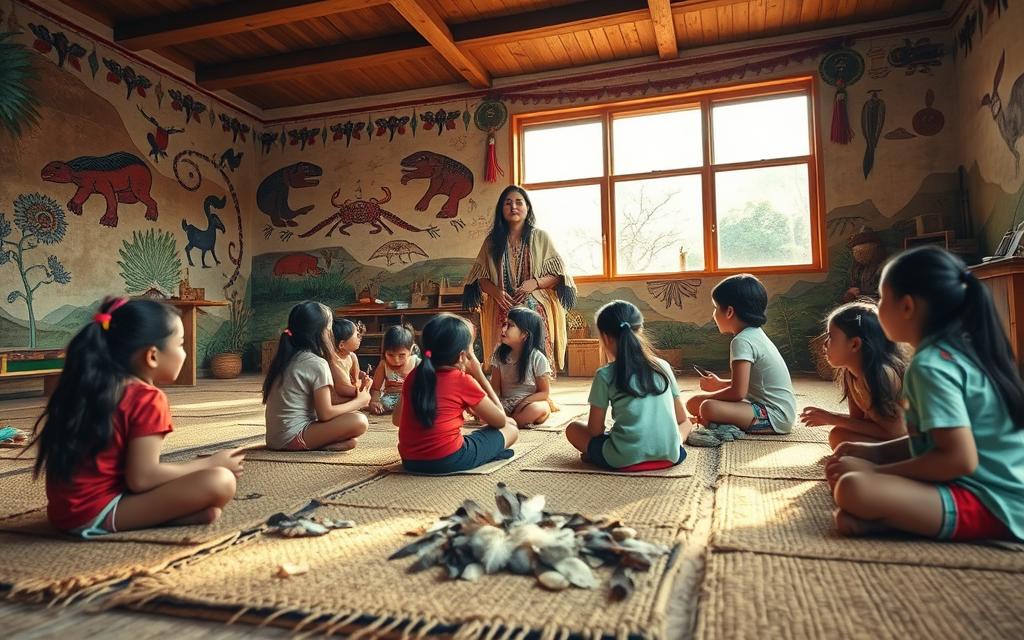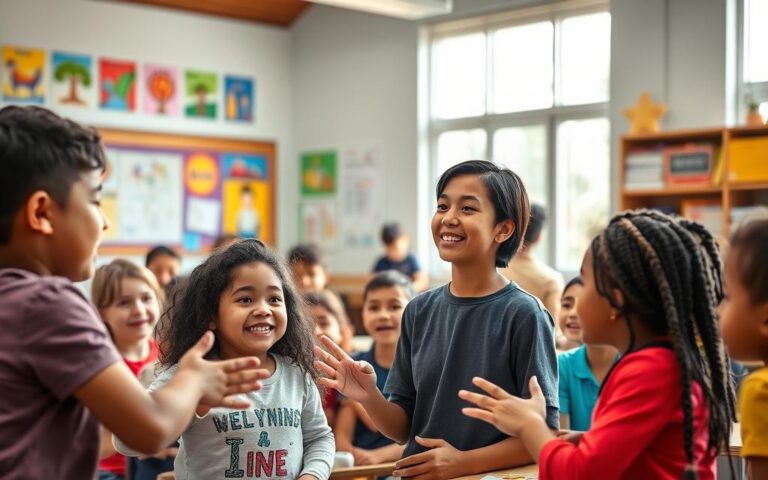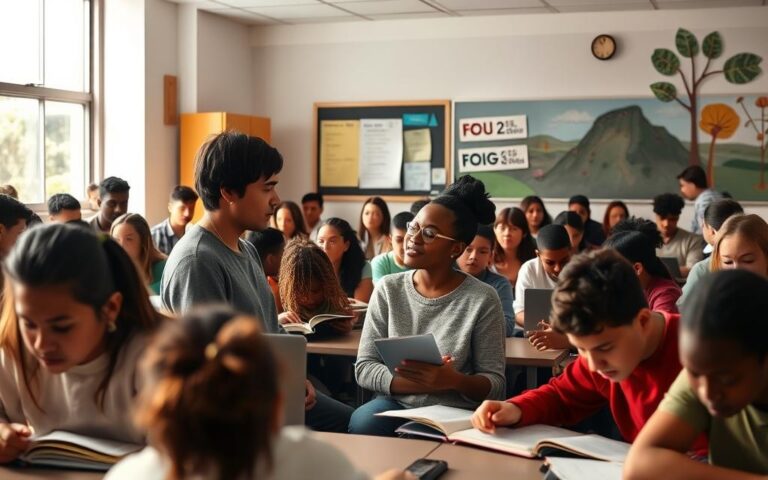adversiment
Indigenous knowledge is deeply rooted in cultural practices, oral history, and learning from the land. It’s a valuable addition to traditional schooling. In the United States, it helps Native students feel more connected and boosts learning for everyone.
Studies show that teaching that respects different cultures makes students more engaged and successful. Experts like Geneva Gay say this approach leads to better grades. The U.S. Department of Education and the National Indian Education Association agree, saying that learning that reflects community knowledge helps more students succeed.
This article will guide you through the world of indigenous education. We’ll cover its history, key principles, and how it benefits students. You’ll learn how to bring indigenous knowledge into classrooms, the importance of Indigenous educators, and examples of successful programs.
We’ll also talk about the challenges, like funding and systemic barriers, and how to overcome them. We’ll discuss policy changes and advocacy efforts. By combining indigenous pedagogy with traditional teaching, schools can offer a more inclusive and meaningful education for all.
Understanding Indigenous Education
Indigenous education focuses on learning from Indigenous worldviews, languages, and community roles. It aims to keep cultural traditions alive while teaching modern skills. This approach helps families, schools, and tribal institutions preserve identity and practical knowledge.
Definition and Importance
This method teaches through community ties, stories, and learning from the land. It values elders and ceremonies as key parts of education. By respecting these, educators help keep cultural traditions alive and improve academic results in tribal schools.
Historical Context
Colonial and federal policies in the U.S. hurt Indigenous learning for many years. Boarding schools and laws tried to erase native languages and separate children from their families. Yet, families and tribal schools kept passing down indigenous knowledge through elders and ceremonies.
Resilience showed up in many ways, like grandparents teaching and tribal-run programs. These efforts helped start tribal colleges and K–12 programs that are reclaiming education.
Current Trends
There’s a growing push to decolonize education in classrooms and colleges. Tribal schools are gaining more control, and tribal colleges like Navajo Technical University offer culturally focused education.
Grants from the U.S. Department of Education support curriculum and language work. Activists are pushing for Indigenous perspectives in education standards and teacher training to make schools more inclusive.
Knowing this history and definition is crucial for educators, policymakers, and communities. Creating learning environments that respect tribal education requires understanding past harms and tribal strengths. This way, schools can build respectful partnerships that honor indigenous knowledge and support decolonizing education.
| Aspect | Historical Reality | Contemporary Development |
|---|---|---|
| Governance | Federal control and boarding school systems reduced tribal authority | Tribal sovereignty over schools and growth of tribal colleges |
| Language | Suppressed by assimilationist policies | Language nests, immersion programs, curriculum materials |
| Curriculum | Eurocentric standards sidelined local knowledge | Place-based learning that integrates indigenous knowledge with standards |
| Funding | Underfunded systems with uneven support | Federal grants and philanthropy aimed at tribal education and revitalization |
| Community Role | Family instruction continued informally | Partnerships with elders, cultural advisors, and community-led programs |
Key Principles of Indigenous Knowledge
Indigenous knowledge is guided by a few key principles. These principles help people learn, live, and teach in a holistic way. They support learning that is whole, social, and connected to the land. Schools and communities can adapt these practical models.
Holistic Learning Approaches
In many Indigenous contexts, learning combines thinking, feeling, spirit, and action. Indigenous pedagogy views stories, craft, and labor as knowledge sites. For example, storytelling builds literacy and moral reasoning at the same time.
Hands-on practice passes technical skill and cultural meaning. Activities like weaving, fishing, or ecological stewardship teach measurement, observation, and ethics. These traditional learning methods make abstract ideas concrete.
Community-Centered Education
Communities shape what and how learners study. Elders, parents, and tribal leaders are involved in teaching and assessment. Community-based education models set goals that include responsibilities to family, land, and future generations.
Assessment is often practical and relational. Success may mean caring for younger people, passing on songs, or contributing to communal projects. Classroom tasks link to shared life and local economies.
Connection to Land and Nature
Place matters. Curricula grounded in local ecosystems teach seasonal cycles, species knowledge, and stewardship practices. A strong connection to land encourages ecological literacy and respect for living systems.
Oral histories tied to specific landscapes anchor memory and law. Students learn maps, weather, and plant cycles while learning cultural values. This place-based focus enriches mainstream lessons and boosts engagement.
These principles can fit with standard curricula to create richer, more active learning. Educators may pair experiential projects, service learning, and cross-subject themes to reflect Indigenous pedagogy. When combined with conventional methods, traditional learning methods and community-based education increase relevance and depth for diverse learners.
| Principle | Classroom Practice | Community Role |
|---|---|---|
| Holistic Learning | Story circles, project-based craft, outdoor labs | Elders narrate, artisans mentor, families participate |
| Community-Centered | Service projects, local problem-solving tasks | Leaders set priorities, community evaluates outcomes |
| Place-Based Education | Seasonal fieldwork, species surveys, land-mapping | Knowledge keepers guide, stewardship activities continue |
Benefits of Incorporating Indigenous Knowledge
Adding indigenous knowledge to classrooms changes the way we learn. It gives students new ways to see history, science, and civic life. Teachers who use culturally responsive teaching and culturally sustaining practices make sure all students feel seen and supported.
Fostering Inclusivity
When we include Indigenous voices in lessons, Native students see themselves. This makes them feel valued and boosts their self-esteem.
Studies show that culturally responsive teaching leads to better attendance and academic success. Schools that embrace culturally sustaining practices see more engagement and fewer dropouts among Indigenous youth.
Enhancing Critical Thinking
Indigenous knowledge teaches us to think about systems. Students learn to see connections between people, land, history, and future. This improves their problem-solving skills in science, civics, and ethics.
Tasks based on indigenous knowledge ask students to think deeply about complex issues. They learn to consider different viewpoints and find solutions that respect the environment and culture.
Valuing Diverse Perspectives
Adding Indigenous content to the curriculum broadens our view. It challenges the narrow views often taught. Lessons that include tribal histories or traditional ecological knowledge help students understand and respect different ways of knowing.
For example, teaching environmental science and U.S. history through Indigenous perspectives. This enriches students’ understanding and fosters respect for diverse knowledge.
When schools focus on Indigenous learning, communities benefit. Tribal sovereignty grows as youth connect with their language and culture. Civic engagement increases as students apply what they learn in class to real-world issues.
| Benefit | Classroom Example | Community Impact |
|---|---|---|
| Increased engagement | Place-based projects using local oral histories | Stronger school–tribal partnerships |
| Deeper critical skills | Systems-mapping of watershed and community | Improved natural resource stewardship |
| Broader perspectives | Comparative units in U.S. history and civics | Greater public awareness of Indigenous contributions |
| Language and cultural revitalization | Incorporating traditional stories and lessons | Stronger intergenerational transmission of culture |
| Higher retention | Mentorship by Indigenous educators | Long-term educational persistence and leadership |
Integrating Indigenous Perspectives in Curriculum
Bringing Indigenous voices into classrooms needs careful planning and strong partnerships. Schools do well when they focus on local tribes and honor oral traditions. This approach connects learning to the land and community.
Small steps can lead to big changes in how students view history, science, and the arts.

Curriculum Design Strategies
Work with tribal education departments and elders to create lessons that matter to the community. Use place-based units that connect local history and ecosystems to various subjects. This way, Indigenous perspectives are woven throughout the curriculum, not just in one month.
Curriculum Resources and Materials
Choose materials from trusted sources like the National Indian Education Association and Smithsonian’s Native Knowledge 360°. Tribal colleges and education departments offer approved curricula and stories. Make sure to use local elders’ knowledge and tribal-approved texts as key resources.
Teacher Training and Professional Development
Focus on culturally responsive teaching and anti-bias practice in teacher training. Work with tribal educators for workshops led by Native scholars. Consider certification programs in Indigenous studies, like those at the University of Arizona and the University of Minnesota, to enhance teacher skills.
Assessment and Adaptation
Use assessments that reflect Indigenous learning goals. Get community feedback on student work to ensure it’s respectful and relevant. Adjust the pace and evaluation to measure local knowledge and culturally grounded skills alongside academic standards.
Effective planning, vetted resources, ongoing training, and community-led assessment are key. This approach creates learning environments where Indigenous perspectives guide both content and practice.
The Role of Indigenous Educators
Indigenous educators are key to making schools better. They change classroom rules, boost student identity, and connect schools with tribal communities. They teach in ways that usual methods can’t.
Impact of Indigenous Teachers
Studies show indigenous teachers help Native students do better in school and feel better about their culture. Seeing teachers who look like them makes students more likely to attend and participate. This helps students feel seen and valued.
Indigenous teachers also inspire students beyond just schoolwork. They show that tribal knowledge and languages are important in class. This helps students feel proud of their heritage and encourages them to aim high.
Unique Teaching Methodologies
Indigenous educators often teach through stories. These stories share values, history, and critical thinking in a way that sticks with students.
They also use apprenticeships, fieldwork, and mentorship. These methods mix practical skills with cultural practices. Sometimes, school days follow ceremonial rhythms, matching the pace of community life.
Building Cultural Bridges
Indigenous educators act as cultural bridges. They help other teachers understand and respect tribal customs and priorities. They guide on how to include ceremonies, language, and local knowledge in lessons.
There are efforts to grow the number of indigenous teachers. Programs, scholarships, and mentorship help attract and keep indigenous educators. This supports teaching that honors indigenous ways and strengthens ties between schools and tribes.
| Area | Practice | Benefit |
|---|---|---|
| Representation | Hiring indigenous teachers and staff | Increases student engagement and trust |
| Instructional Methods | Story-based learning, apprenticeships, land-based projects | Enhances retention and real-world skills |
| Calendar & Culture | Ceremonial rhythms, community events in school schedules | Aligns schooling with cultural life |
| Community Relations | Cultural liaison work between schools and tribes | Improves mutual understanding and respect |
| Workforce Development | Scholarships, grow-your-own programs, mentorship | Builds a sustainable pool of indigenous educators |
Examples of Successful Indigenous Education Programs
Real-world programs show how tribal education can strengthen culture and learning. These examples highlight community-based education models, language work, and higher education partnerships. Other schools can adapt these models.
Case Study: Native American community schools
Tribal schools run by nations like the Navajo Nation blend state standards with cultural curricula. Programs supported by the Bureau of Indian Education have raised attendance and reinforced cultural continuity.
Students in these K–12 settings often report stronger identity and higher engagement. Tribal education that centers local elders and traditions builds trust between families and schools.
Case Study: Bilingual education initiatives
Language immersion programs produce measurable gains in fluency and academic skills. The Cherokee Immersion School, Hawaiian language immersion schools, and Alaska Native language efforts show clear progress in speaking and literacy.
These bilingual education initiatives succeed when communities lead planning and when schools set long-term, measurable goals for language outcomes.
Case Study: University programs featuring Indigenous studies
Colleges like the University of New Mexico and tribal institutions such as Salish Kootenai College offer Indigenous studies. These programs train teachers and advance research on Indigenous pedagogy.
Such programs link scholarship to classroom practice. Graduates often return to their communities and strengthen community-based education through research and leadership.
Lessons learned
- Community leadership drives relevance and trust in tribal education.
- Long-term commitment and clear metrics support language revival in bilingual education initiatives.
- Sustainable funding and partnership with higher education strengthen Indigenous studies and teacher preparation.
Challenges Facing Indigenous Education
Public schools on tribal lands struggle with big gaps in learning and trust. They often lack the funding and resources needed. This includes staff, materials, and infrastructure for quality programs.
Reports from the Government Accountability Office and the National Congress of American Indians show big spending gaps. They compare Native schools to non-Native ones and highlight trouble getting federal grants.
Funding and Resources
Not enough money affects basic needs, special education, and career paths. Many schools rely on funds from the Bureau of Indian Education, which doesn’t always meet local needs. This limits access to modern facilities, school counselors, and extracurricular activities.
Advocates want more money for tribal schools and for federal grants to match tribal goals. Grants for building capacity help tribes manage and apply for more funds.
Cultural Misunderstandings
There are many mistakes, like tokenism in lessons and misusing ceremonies. These actions hurt trust between teachers, students, and tribal nations. Not listening to tribes can turn good ideas into cultural mistakes.
Training that respects tribal culture and partnerships with tribes can help. Schools that work with elders and language keepers build trust. They also move towards education that values Indigenous knowledge.
Systemic Barriers to Access
Many reservations are far from cities and lack good internet. This makes online learning hard. Legal and bureaucratic issues make starting tribally controlled schools hard. There are also not enough Indigenous teachers.
To fix these problems, we need better internet, easier rules for schools, and more Indigenous teachers. Policy changes and funding for buildings can help improve things for good.
Good steps include fighting for fair funding, listening to tribes, investing in buildings, and training teachers to respect cultures. These actions aim to fix funding gaps, avoid cultural mistakes, and overcome barriers. They honor community values and knowledge.
Policy and Advocacy for Indigenous Education
Making a policy for indigenous education is about respecting tribal sovereignty. Laws like the Every Student Succeeds Act (ESSA) and programs like Impact Aid help. They let tribes control schools and fund programs that keep their culture alive.
Creating good policy starts with listening and using data. By tracking things like attendance and language use, we can see where help is needed. This helps tribes get the resources they need for their schools.
Importance of Responsive Policies
Responsive policies respect tribal control and fund their programs. They let tribes decide what’s best for their schools. This means hiring teachers who understand their culture and creating lessons that reflect their history.
To make things better, we can use ESSA to tailor how schools are judged. We can also use Impact Aid to help students on federal lands. These steps help schools do better and keep their culture strong.
Engaging with Indigenous Communities
Working with Indigenous communities means listening and respecting their decisions. This is called government-to-government consultation. It makes sure decisions are made with the tribe’s agreement.
Good practices include letting tribes lead and creating lessons together. We should follow their rules, invite them to planning meetings, and hold meetings on their land if they ask.
Role of Nonprofit Organizations
Nonprofits often help by filling gaps in resources and support. Groups like First Nations Development Institute and the National Indian Education Association offer training and grants. They also help with legal issues and advocacy.
Successful partnerships show how to make a difference. A tribe, a school district, and a nonprofit can work together. They design a bilingual program, get funding, and track how well it’s doing. This model can grow when everyone shares what they’ve learned.
To make change, we can build coalitions, write grants for cultural programs, and use research to influence laws. Working together and using our voices can lead to better policies for tribal education.
| Action | Who Leads | Expected Outcome |
|---|---|---|
| Government-to-government consultation | Tribal councils and state education agencies | Stronger respect for tribal sovereignty and clearer agreements |
| Data collection on student outcomes | Tribal education departments and districts | Evidence to support funding and targeted programs |
| Co-created curricula | Tribal educators, classroom teachers, nonprofits | Culturally sustaining lessons and higher student engagement |
| Legal advocacy and capacity building | Native American Rights Fund and similar groups | Stronger legal protections and improved administrative capacity |
| Grant writing and funding partnerships | First Nations Development Institute, foundations, tribes | New programs, teacher training, and language revitalization support |
Future Directions for Indigenous Education
The future of indigenous education is about mixing old traditions with new technology. Schools and tribal programs are trying out new ways. They focus on community needs and use modern tools.
Innovations in Educational Technology
Digital tools can help teach about local places without losing cultural values. For example, there are language apps made with tribal teams. There are also virtual storytelling and GIS mapping projects.
Technology should be made with Tribal Nations. This way, it fits local ways and views.
Preservation of Language and Culture
Keeping languages alive needs immersion schools and master-apprentice programs. Schools like those in Hawaii and Cherokee show success. Digital archives and linguist partnerships help too.
Vision for Collaborative Learning Environments
Imagine schools as community centers. They teach STEM, arts, and civic skills with Indigenous knowledge. This brings together tribal governments, schools, and more.
This approach helps grow local leaders. It supports learning from early school to college.
To move forward, we need more funding for tribal programs. We also need better teacher training and policy changes. Investing in technology and infrastructure is key. These steps will help make indigenous education strong in the U.S.



